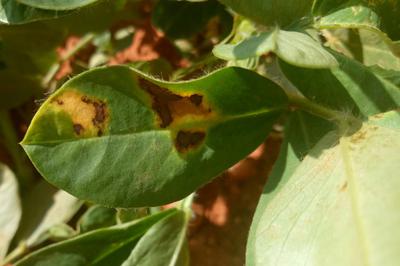Phyllosticta Leaf Spot
Nothophoma arachidis-hypogaeae
Fungus
In a Nutshell
- Light tan lesions with darker margins on leaves.
- Lesions become grayish, dry up, fall off.
- Leaves with holes.
Can also be found in
Symptoms
Circular to irregular light tan lesions (1.5 to 5 mm) surrounded by marked reddish-brown margins appear on leaves. As the disease progresses, the center of the lesion becomes grayish and dry up, in some cases eventually falling off, leaving a hole and giving the leaves a ragged appearance. The lesions may coalesce to form large, irregular, necrotic patches. Black, pepper-like fungal specks are visible within the diseased tissue on both leaf surfaces.
Recommendations

Organic Control
Sorry, we don't know of any alternative treatment against this fungal disease. Please get in touch with us in case you know of something that might help to fight this disease. Looking forward hearing from you.

Chemical Control
Always consider an integrated approach with preventive measures together with biological treatments if available. Damage from Phyllosticta leaf spot is usually minimal, therefore fungicides are rarely recommended.
What caused it?
The fungus can remain viable for about one year in infected crop debris in the soil. From the soil, it usually infects damaged and necrotic tissues of plants that are affected by other diseases or injured during field work (secondary infection). It then spreads to healthy tissues and triggers specific symptoms. Optimum conditions for fungus development and disease progression are temperatures between 25-30°C and pH values between 5.5-6.5. Phyllosticta Leaf Spot is not considered a major disease of peanut.
Preventive Measures
- Use resistant varieties if available.
- Be careful not to injure plants during field work.
- Irrigate in the morning, to avoid wet soil conditions during the night.
- Remove crop debris after harvest and burn it.
- Spread lime in fields to increase soil pH values.



